 Gencodia
Gencodia
 Class: M
Class: MType: Moon
Status: Habitable
Satellites: None
Location:
Moon of gas giant Xothos
Beta Quadrant
Affiliation:
United Federation of Planets
Original Compiler: Cdr T’Kirr
Gencodia – Colonization Project
(Supplemental Database Entry)
Gencodia
Location: (0, 0, 0) Unexplored space beyond Federation border
– Gas giant – mostly orange with bands of purple and red clouds, and a magnificent ring system.
Class: M, largest moon (compare – Ganymede in Jovian system) of hundreds
– Tidally locked to the planet “Xothos” within the star’s habitable zone
Sentient Species: None
Description:
The side facing away from the planet has a normal day/night cycle. During the day, the dark side of the moon also experiences its day cycle by the sun’s reflected light on the planet, or “planet shine”. During the night cycle, the sun is behind the planet. According to the first discovered artifact, the orientation of the moon with regard to the planet has shifted somewhat since its creation.
Theories:
– Possibly culturally significant astrological event when Gencodia is passing “Yros”, the nearest visibly significant moon
– An event when Gencodia and the three other moons align with “Xothos”, roughly every sixty-four hundred years – within the next 100 years
– The nearest moon the first discovered artifact’s glyphs identify is probably close to the median size of the moons of the planet, but it has an exceptionally long orbit, nearly half the orbital speed of Gencodia. The transits could actually take a significantly long time
– At least 3 different lunar transits
– Orbital alignment would have occurred about 850 years after the creation of the first discovered artifact
Colonization Site
Location: (0, 0)
Temperature: 19 – 28 (initial recordings in progress)
Climate: Temperate
Resource Rating: Plentiful (types to be determined)
Fauna: Warm Blooded (scans incomplete)
Flora: Various Embryophytes (see botanical database entry for scan results). Common tree life includes deciduous & evergreen.
Description:
The primary colonization site is near the dark edge of the light side of Gencodia. The area experiences direct sun exposure occasionally during its long night when the planet moves just out from between Gencodia and the sun, but the sun rises no more than twenty degrees above the moon’s horizon. The twilit landscape, purplish-orange reflected light from the planet which looms large in the sky, providing an eerie, almost silencing glow over everything.
A river runs northeast to west about half a click northwest of original beam down site, just northwest of the pillar. The river continues west to bend southward under the pass just beyond the Operations Base, then continues westward along the southern edges of the ruins before dropping off the cliffside. Local resources expected to sustain colony after one to two years. Scan results suggest the area is ideal for agriculture and animal husbandry.
A convenient roost in the tallest tree over the ruins shows signs of a large, possibly predatory flying creature. Personnel are advised to be watchful and avoid confrontation if found.
Operations Base
Location: (0, 0) (Construction Complete) Crest of the pass, 3.8km W of “Ancient Pillar”, 1.5km E of “Ancient Ruins”
– provides a nearly 360deg view
– western edge drops off into a forest valley
Personnel Assigned: Current
– Adm A.C Zuriyev
– VAdm Ian Blackthorne – Supervisory
– Cdr T’Kirr – Supervisory
– Two crewmen have secured the path leading east
Lower Site
Personnel Assigned: Current
– Ens Lucas Taylor – ASec, head of secondary science team (primarily archeologists and surveyors)
Ancient Pillar
Location: (0, 0) Science Camp One, NW of original beam-down site, 3.8km E of Operations Base, 5.3km E of “Ancient Ruins”
Personnel Assigned: Current
– Cdr Kathryn Harper – Translation
– LtJG Alexis Wright – CSec
Description: Remains of an ancient column, crafted from white stone (similar to marble) with traces of green moss, partially standing and partially fallen, covered in vines.
– Structural components analyzed – See Science attachment
– Surrounded by 12 cut stone cubes in a circular pattern – 58cm on a side and covered in writing, well preserved, very little weathering
– Record of achievements in religion, science, art, literature, in commemoration of an anniversary
– Quarried about 20,000 years ago, predating all previous Federation? discoveries
– Images, dimensions and environmental samples obtained (refer to media archive) by LtJG Alexis Wright
– SR survey probes dispatched by Cartographer Gremizae per LtJG Alexis Wright
– Finely detailed glyphs carved with a precision tool (possibly lasers), now weathered, reminiscent of the Greco-Roman period
– An array of at least a dozen mobile sensor modules are set up to read the underside of the pillar – PADD-synced
– Anti-grav lifts placed in three locations (marked by six red-glow spider bots ) to maintain structural integrity, supervised by a geologist
– 3m shield generator perimeter originally established by LCdr Busard until discovery of its surrounding stones. Perimeter was expanded to include all thirteen artifacts
Translation: (in progress) UT not working on it upon arrival – language amazingly complex, beautiful, poetic
Scientific:
– Differential/multi-variable calculus equations discovered first
– Indication of the transit patterns of the larger moons that are orbiting between the colony moon and the planet – not big enough to eclipse but observable by the naked eye
– Rate of change of the moon’s orbit with respect to the gas giant over a thousand year period
– Upright section contains writing, some of the characters being used as variables in the equations in the mathematical section
– Section of writing appearing different describes specialized herbal medicines, shamanistic healing, and advanced surgical techniques
Religious: Holy scripture in calligraphy
– “XOTHOS, the benevolent watcher, protector of all life, shall forever remain with us, lighting our way.”
– planet in the sky was considered a benevolent guardian/deity, but this belief fell out of favor with scientific advancement
Verbal:
– “Yes” roughly translates as “Kee”
– Chronological last entry – Gencodians left Gencodia by “transcending reality”
Theories: (to be proven by Science personnel)
– Not representative of the apex of their cultural advancement
– Significant to predicting astrological events, specifically those as relate to “Xothos”
– mentions flying, possibly on native winged animal, and concentrated light, possibly lasers
– Gencodian emigration and travel between dimensions similar to that reported by the “Traveler” species
Ancient Ruins
Location: (0, 0) Science Camp Two, 1.1km E of ocean cliff top, 1.5km W of Operations Base, 5.3km W of “Ancient Pillar”
Personnel Assigned: Current
– Cdr Percy Busard
– Dr. Roxanne Carre
– Sgt McGann
-2Lt Kuari
Description: Crumbled dome shape
– Entry somewhat widened by decay
– All areas within currently illuminated by standard issue marine glow sticks
– Bio Sample 630-469 – DNA not found in medi-lab database but shares similarities to that of the Rucara
Lift Pyramid: Pyramid shaped structure within the dome
Upon discovery, a “honeycomb” construction was found to absorb scanner waves. Limited success with simple ultrasonic bombardment yielded a rough image of the hollow interior, suggesting the structure was not intended for close range scans.
A small perimeter was set up around it to keep personnel from disturbing any possible relics outside the area. The fine divide running down the center of one pyramid face was found to be airtight. Level 9 containment field emitters were placed to prevent release of possible long-dormant alien pathogens, and the seal was opened by engineering with a cutting laser. The entrance was opened with vacuum seal handles to either side to uncover a dark shaft leading down 81 meters to the top of a lift car.
Personnel entering are required to wear sealed armor suits and extra oxygen tanks.
Lift Shaft:
Travel down the shaft is currently achieved by a length of rope. Identical metallic strips, similar to mag lev strips used in turbolift shafts, run its length. The strips have strong magnetic properties, although time has likely diminished what they once held.
Progress downward is currently limited to a lift car, entered by a separated hatch on its ceiling. The door of the car was opened by a laser prybar to reveal a chamber.
Chamber: Expansive
– walls etched with symbols
Colonel McKnight’s team is currently split into groups of three exploring the chamber, reporting in every fifteen minutes. LtCdr Busard has several “minibots” imaging and recording data into a 3D model, uploading to her PADD every 5 minutes. Dr. Carre is conducting tests within the sealed atmosphere with a medi-scan air sampler and has dispatched several small teams to set up satellite medi-scanners. No anomylous readings found until the Spherical Chamber is “powered up”. Preliminary scan results complete. Nothing harmful found.
Passageways:
– Right fork leads to Spherical Chamber
Spherical Chamber:
– Walkway (~1.4m wide) leads to a platform (2.4m diameter) in the center
The console on platform has no buttons but is covered in etching and two three-digit handprint depressions. These depressions activate the room, which involves the safety railings to rise out of the platform and the entire platform to rise within the chamber and the appearance of a holographic display of the surrounding solar system. The display states time passed to be 19,522 years, 64 days, 16 hours, 53 minuntes, and 12 seconds since last system access, possibly right before one of the planetary/lunar major alignments. The display and platform, along with the rest of the room powers down once the depressions are released.
Shuttle Depot:
– Storage bay connected by both ladder and lift (Inactive) to actual launch shaft (Length approximately .7 km) one level below.
Storage bay was accessed via careful disabling of security on locked and inoperable entryway door. The precise reason for this greater level of security in that area is presently unknown. The storage bay ranks among the more massive chambers yet discovered, housing a half dozen air shuttles, as well as dormant machinery assumed by Lieutenants Quinn and Gant to be some apparatus for moving and loading the aforementioned shuttles.
The actual mechanisms in place for launching a shuttle are somewhat eclectic, and unique in the differing levels of technical ability required for the construction of different segments, but overall appear typical of Gencodian engineering sensibilities, an obvious stress placed on efficient usage of energy. The shuttle itself is placed at the top of a downward sloping “Pinewood Derby” style ramp, an initial push provided by the repulsion of two positive magnets. As the car travels along the ramp, the resulting friction heat is converted into usable energy by a series of small generators housed underneath the ramp. These generators in turn power a more advanced mag-lev system further down the ramp. The potential power of this system, or whether it is capable of a variable charge is at this time unknown, but was shown able to propel a single shuttle at speeds equivalent to approximately 140 mph.
Shuttlepod:
– “silvery missile”
– seats at least two persons
– speed recorded at just under 200kph
– while in flight, a soft, pinkish, transparent energy field envelops the passenger section
– while in flight, a flat, wide, elliptical rim extends to form “wings”, the undersides a bright blue glow (mag lev strips, lift, propulsion?)
Theories:
– Chamber 3B – socializing area, toilet, or storage depot
Cliff Face
Location: (0,0) 1.1km W of Ancient Ruins
Personnel “Assigned”: Current
– Lieutenant Rodney Quinn
– Lieutenant JG Sarah Gant
Description: Sheer face topped by the Ancient Ruins site and footed by crashing ocean waves
– Shuttle Depot ejection outlet found, altitude 274m
Echo One Outpost
Location: (0,0) distance from other sites yet undetermined
Personnel Assigned: Current
– Col Douglas McKnight
– Philips
– Mkkran
Description: Automated Emergency Comm Relay (Under Construction), Microtorpedo Battery (Under Construction
– Atop highest peak sharing line of sight with Operations Base
– Features a receiver for a Helios signaling laser to be installed at the Operations Base. Despite a distance of 9.4 km between the two, atmospheric precipitation levels have been calculated to represent an acceptably minimal risk of beam diffraction. Simple Morse code is used to instruct the comm array to relay either a specific, or (in the event that the operator is pressed for time before evac.) a number of pre-programmed distress signals. In this way, given the long distance and the “old fashioned” method of message sending, a distress call is rendered immune to most conventional jamming techniques employed at the main settlement.
– Launcher itself includes an onboard magazine for 12 torpedoes, as well as an independent sensor suite to guide them. Storage for 100 more rests directly underneath it, connected by an automatic feeding mechanism.
– Entire outpost monitored by a security camera system administered by a low grade AI. Any unauthorized user attempting to access the equipment is immediately recognized, and local authorities alerted.
– Stationary shield emitter installed, to be activated automatically in the event that hostile aircraft are detected. Colonel McKnight has left a recommendation for the next wave of settlers that a larger generator should be installed if a stronger shield is desired.

